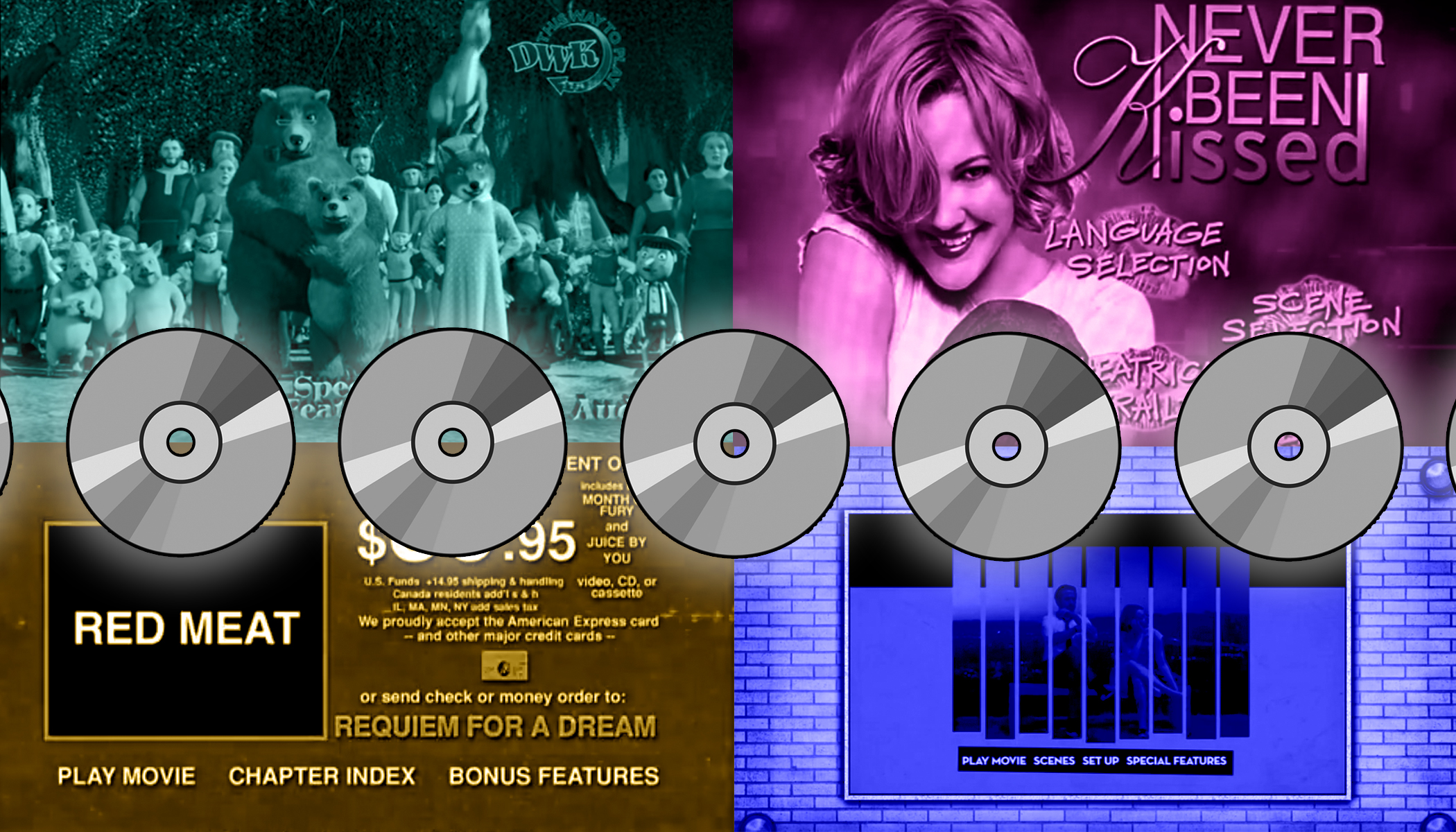The lost art of the DVD menu
The screensaver of our lives


For almost as long as I've been watching movies, I've been falling asleep to them. As a kid, this would sometimes mean starting something on TV — You've Got Mail, maybe — and waking up hours later to Sleepless in Seattle. Most of the time, though, I watched movies we checked out from our grocery store; as a result, my late night crashes were primarily set to the soundtrack of the DVD menus that would pop back up again after the credits rolled.
While I don't fall asleep on the couch quite as often anymore, I did recently resubscribe to Netflix's DVD delivery service in order to access movies that aren't streaming for free. Now that I'm back to relying on physical media, I've rediscovered the DVD menus I'd been so familiar with in the aughts — an art I'd sorely missed in this age of on-demand viewing, shuttered video stores, and computers without CD drives.

According to the Motion Picture Association of America, DVDs and Blu-ray sales nearly halved in the five years between 2014 and 2018, plunging from annual sales of about $25.2 billion globally to a meager $13.1 billion. Over the same period, digital sales grew from $15.7 billion globally to $42.6 billion. It's not that people aren't watching movies anymore — they just aren't watching physical copies.
The Week
Escape your echo chamber. Get the facts behind the news, plus analysis from multiple perspectives.

Sign up for The Week's Free Newsletters
From our morning news briefing to a weekly Good News Newsletter, get the best of The Week delivered directly to your inbox.
From our morning news briefing to a weekly Good News Newsletter, get the best of The Week delivered directly to your inbox.
Due to the more sophisticated technology available on streaming websites today, you would think this would mean we'd be living in a corresponding golden age of menu design. The opposite has unfortunately been the case; Netflix has an especially detestable and unimaginative menu that auto-plays trailers, while Amazon Prime is equally bad, with boring, static landing pages.
While early DVD menus were often also static, or relied on background montages similar to what Netflix uses now, there were nevertheless smart innovations at the turn of the millennium. One notable example, 2001's Shrek, stands out due to its original approach to menu design. Instead of showing footage from the movie, the menu features a row of characters who appear to gaze out patiently at the viewer. The donkey's calls in the background of "pick me, pick me!" are as if in appeal to whoever has the remote in hand.
Many of the iconic DVD selection pages to follow were similarly self-aware or broke the fourth wall, addressing viewers directly. The menu for Zoolander (2001), which came out several months after Shrek, was also relatively simple in design, but relied on the use of original voice-overs to entertain home audiences.
Among the more famous DVD menus to address viewers directly in this way was House of 1000 Corpses in 2003. On it, the character Captain Spaulding appeared to service the viewers, with increasing irritation and insults if you didn't promptly make a choice:
A free daily email with the biggest news stories of the day – and the best features from TheWeek.com
Another menu to fall into this genre was Harold & Kumar Go to White Castle (2004). As the characters Harold Lee and Kumar Patel drive down the road on the menu screen, they marvel at the special feature options beneath them. If the DVD owner was to wait a few moments without picking one, Harold and Kumar would get antsy.
"It's really not that difficult, there's only — there's only four of 'em, come on," Kumar insists at one point.
Other DVD menus were designed to fit the theme or genre of the movie. Sometimes this was obvious — it seemed for awhile as if every science-fiction movie had its menu set in a ship's dashboard — but other iterations could be quite inventive. 2 Fast 2 Furious (2003), for example, made itself look like a racing game start screen, and the menu for Borat (2006) kept up the film's mockumentary style and broken English.

Some DVD menus took advantage of the fact that the discs were intended for home televisions, and used the format to their advantage. Wayne's World made itself look like a cable television menu, complete with a weather report, while Requiem for a Dream (2000) dressed itself up as a commercial to the point that it was almost hard to find the selections. Likewise, Paranormal Activity (2009) used an intentionally basic home movie menu in keeping with the film's found footage pretensions.

Maybe the greatest trick menu of all, though, was on the Fight Club special edition Blu-ray. When viewers popped the disc in, a Never Been Kissed DVD menu would come up before eventually glitching out and offering the Fight Club play options:

Easter eggs and other "secret" special features provided extra incentive for people to explore menus, from the terrifying phantom button on The Ring's disc to the chronological viewing option on the special edition Blu-ray for Memento.
Not all menus necessarily needed to be clever, funny, or jokes to be great, though. Many were quite simply gorgeous works of digital art, as was the case with the widely beloved menu for Sin City (2005). Despite belonging to a later era of DVD menus, The Social Network used an extremely clean and elegant design. The Criterion Collection menu for Fear and Loathing in Las Vegas was another classic, featuring a video of artist Ralph Steadman doing the iconic calligraphy for the title. Most recently, La La Land's Blu-ray menu has gotten praise for its minimalist yet eye-popping design.
DVD menus weren't only pieces of art, though. They frequently turned into inadvertent backdrops to our lives — those snoozes on couches, but also the wind-ups for a family movie night, the kitchen blabber while waiting for the popcorn to pop, the after-movie heart-to-hearts during which the rest of the world would fall away. By occupying a space of transition, DVD menus were often the closest thing our lives had to a screensaver.
Some websites have tried to rekindle this magic. And of course, many people do still buy DVDs and Blu-rays, even as the devices to show them are being phased out. But along with the other consequences that come with losing physical media is this — that even as movies live on in afterlives as digital ghosts, their menus never evolved for the streaming era. It is our loss.
Jeva Lange was the executive editor at TheWeek.com. She formerly served as The Week's deputy editor and culture critic. She is also a contributor to Screen Slate, and her writing has appeared in The New York Daily News, The Awl, Vice, and Gothamist, among other publications. Jeva lives in New York City. Follow her on Twitter.
-
 A luxury walking tour in Western Australia
A luxury walking tour in Western AustraliaThe Week Recommends Walk through an ‘ancient forest’ and listen to the ‘gentle hushing’ of the upper canopy
-
 What Nick Fuentes and the Groypers want
What Nick Fuentes and the Groypers wantThe Explainer White supremacism has a new face in the US: a clean-cut 27-year-old with a vast social media following
-
 5 highly amusing cartoons about rising health insurance premiums
5 highly amusing cartoons about rising health insurance premiumsCartoon Artists take on the ACA, Christmas road hazards, and more
